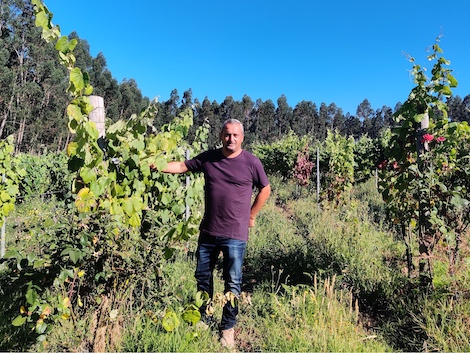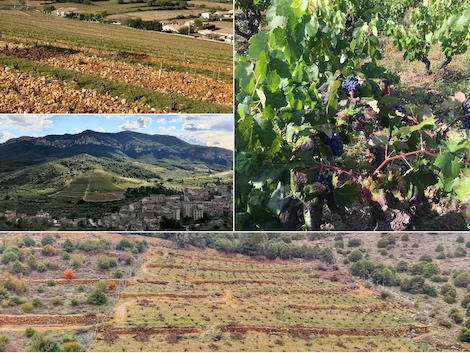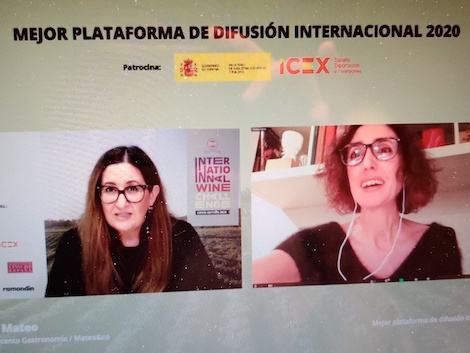Forjas del Salnés, the producer who revived the red wines of Rías Baixas

Francisco Méndez, blacksmith, grape grower in Meaño and member of the team who founded the Rías Baixas DO, never imagined that the family's vineyards he planted to Caíño, Espadeiro and Loureiro back in 1980, against everyone's advice, would become the source of some of Galicia's most acclaimed and respected reds.
Growing red varieties was a deeply-rooted tradition in the area —they were part of the family diet— but the commercial success of Albariño, which today accounts for more than 98% of the total grape production in Rías Baixas, relegated them to a residual role or directly to being uprooted.
Nobody believed in the potential of the reds from Rías Baixas until Rodrigo "Rodri" Méndez proved to the world that his grandfather's vision was right. Luckily, winemaker Raúl Pérez, who was in Salnés at the beginning of this century looking for grapes to make his Sketch Albariño, crossed his path and they reached a deal. Méndez let him choose the family plot he liked best in exchange for lending him a hand with his reds. This led to a professional relationship and a deep friendship that continues today not only in Rías Baixas but also in Ribeira Sacra, where they make the Castro Candaz wines.
As Méndez said in an online conversation with Xoan Cannas, the director of Instituto Galego do Viño during the lockdown, making the wine was a challenge because they had to fine-tune their farming and had no history of making wine from these varieties. But the hardest part was selling it, at a time when ripe, oaked wines were in demand. "It was 2005 and our reds, which were totally different to what was available then, were being rejected. Raúl helped us a lot by carrying them under his arm when he travelled abroad to meet his importers,” Méndez remembered. "And they weren't cheap. We sold them four at a time and so, when we sold four bottles, we said 'we've sold a case'.”
These days, Forjas del Salnés sells its cases with six bottles and demand exceeds supply, which has remained unchanged over the last 15 years for its three original single-varietal reds: three or four Espadeiro barrels, 1,000 litres of Loureiro and some 3,500 of Caíño, which are sold under the Goliardo brand. For some years now, the bodega has also been making a generic Goliardo (previously called Bastión de la Luna) blending the three varieties.
The future lies on higher ground
His Meaño wines, both red and wine, are made under the brand Rodrigo Méndez with names such as Sálvora, from an old Albariño vineyard next to his parents' vegetable garden, Cíes or O Raio da Vella.
Among his latest projects is a plot where he has recently planted Albariño and Brancellao, a variety that is rare in the area but one he is very excited about, and Tras da Canda, a 1.5ha vineyard among eucalyptus trees that he planted nine years ago on the boundary with Sanxenxo. It is a sun-exposed opening in a woodland area at an elevation of 230 metres with sandy and quartz soils. Rodri anticipates a great future for this area. "It wasn't planted in earlier times because it was impossible back then to climb these paths with the oxen and carts when it rained, but I think that in 10 years' time this will be full of vines because the quality of the grapes is excellent," he says.
In Tras da Canda, where three wines with the same name are sourced, he grows red varieties but also Albariño —a selection of the best vines from Finca Genoveva, a historic vineyard with ancient plants— and Caíño Blanco, a rare variety in Salnés, although somewhat more present in O Rosal, in the south of the DO, which he believes will prove good for blends.
Another innovation that Méndez introduced in this vineyard was the trellis, seeking a greater planting density (9,000 vines/ha as opposed to 1,000 on the traditional pergola) and lower yields. He has achieved his goal with the red varieties, but some of the whites will be trained in pergolas because he feels that the vines are suffering excessively. "I also need to pull out some plants —with the competition, the heat and lack of rain, the vines start to absorb the juice from the grapes,” admits Méndez. An added problem are the eucalyptus trees surrounding the vineyard. The trees protect the vines from the sea wind, but every three years they have to bring in a bulldozer to pull out the enormous roots, which look like trunks and take away water and life from the vine.
Coexistence and treatments
Despite the challenges of virgin areas like Tras da Canda, Rodri is convinced that growers must make an effort and move up to higher areas, not only because of climate change but also because of the rising number of homes in an area that competes with tourism and where the price per hectare can be as high as €200,000.
"The soil is excellent to make wine but I have problems with the neighbours. People complain because we apply treatments, even though we go at 07.00 am if there are houses nearby to disturb them as little as possible," he explains. "The coexistence of tourism and farming is tricky; the regulations should be clearer and perhaps the old vineyards should be allowed to remain, but new vineyards should not be allowed next to a house.”
In challenging years, when more anti-fungal treatments are required, conflicts multiply. "I use common sense and treat only at the right moment, but a vineyard like Genoveva, with vines aged 170-180 years old, or Sálvora in Meaño, need systemics in a year as difficult as 2020. Otherwise, you'll not only lose your crop; you'll lose the vineyard", says Rodri, who farms around 10 to 12 hectares in the Salnés valley. "It's true that things can and should be done better, but changes cannot be made overnight.”
O Pradiño is one of these vineyards that lies between houses. With these grapes, Méndez, a lover of the red wines of Burgundy and Oregon, makes, in partnership with Raúl Pérez As Covas, a Pinot Noir whose production, outside of the DO, is limited to 700 bottles. It used to be trellised, but as in Tras da Canda, it has now been trained to pergolas to maintain the acidity, increase yields and reduce alcohol levels.
"I am impressed by the plant's adaptation. The Pinot plants on the estate are younger than the Albariño, but they are lush and produce more grapes," says Méndez. "Some people don't understand this, but I always say: in my experience, Pinot is better adapted than Albariño and I Caíño. In these sandy soils, Albariño struggles to grow. The conclusion I draw is that Pinot is also a creeper and when you give it some space, it self-regulates. The quality here is terrific, so this vintage I may release it as a single vineyard.”
In O Pradiño, the lack of water in the soil is evident so they introduced irrigation to get the vines started. "I don't really like it but if we don't water, the leaves turn yellow and come harvest time the plants are burnt," explains Rodri. "Watering is something we have never done before, but the best vineyard sites, the poorest ones, are going to suffer badly as a result of climate change.”
He also makes wine from an old vineyard on poor sandy soils near Montalvo beach where Raúl Pérez and Chicho Moldes, from Fulcro, have also made two Albariños. Rodri's is called Arenas de Arra and the first harvest, 2017, will be on release soon. "At first the wine didn't say anything to me, but after the fifth month it began to gain volume without losing its acidity. The same happens to Chicho. Now it's really vibrant, like drinking Albariño pop rocks, and the finish is pure velvet. I think it's one of the most special Albariños I've found in the Salnés," says Méndez, who makes a dozen whites from this variety.
Finca Genoveva or a journey to the Salnés valley 100 ago
Although he is a strong advocate of planting new vineyards to safeguard the future of the area, he does not pass up the opportunity to farm good old vineyards such as the two and a half hectares of Finca Genoveva, from which he makes a white and a red that are undoubtedly among the finest wines in Galicia. "Rodri discovered this estate thanks to his sulphate supplier, who told him that in Barro there was an old vineyard that was a bit neglected," Chicho told us, always grateful to Rodri for his generosity and all the help he has given him. "When he got there he was amazed at what he found —those amazing 180-year-old Caíño and Albariño vines!"
These 2.5 hectares, says Rodri, open a window onto the Salnés valley 100 years ago, not only because of the long arms crawling up the pergolas, but also because of the small cellar, now out of use, in which Lola, the octogenarian owner of the estate (Genoveva was her mother), keeps Albariños and Caíños that were bottled 30 years ago and the barrels in which they were made. The corks are not in good condition, but when one is in one piece, the wine is spectacular.
"When I started making wine, oak-aged Albariños were out of favour, but when you walk into this cellar, you see that 2,000 litre oak casks were the norm in the old days. I came here one day with Raúl and José Luis Mateo and we said, 'we have to reclaim this'. Back then, wines were made with native yeasts, without temperature control and stainless steel tanks, just like those stored in this old winery. This is the style we have adopted for our wines since we visited Finca Genoveva", explains the winemaker. "There's a local saying that goes 'Albariño in large containers and broth in a small pot'. This is our heritage".
A “hidden treasure” in Morrazo
Morrazo is another historical area where Méndez makes two wines called O Santo do Mar, one of them with Tinta Femia, a variant of Caíño. Although it is on the other side of the Pontevedra estuary, Morrazo never joined the DO Rías Baixas, probably because there were not enough producers pushing for its admission, but it has been a PGI since 2018. There, the traditional Galician smallholdings or minifundio helped to preserve the old vines but, as it happens in Ribeira Sacra, it also condemned them to be abandoned.
"It's hard to find people to sell you vineyards, because it's a seaside area. And renting without grants is practically impossible. I always say that the authorities should offer incentives to protect and recover old vineyards, which are our heritage. Besides, these are sandy beach soils where the vines need a lot more time to grow. That's why people abandoned them, but the region is a hidden treasure,” says Rodri. "I encourage more producers to come to Morrazo because one person alone cannot build a road. It's something I discuss a lot with Raúl; we need people who share a common vision. In Salnés we encouraged Xurxo [Albamar], Chicho [Fulcro] and Eulogio [Zárate] to make red wines because it is necessary to develop the region and unite to transmit what we have here.”
The importance of oak
Finca Genoveva's inspiration is evident in the rows of oak casks inside the winery, located in an industrial estate on the outskirts of Cambados. Méndez began at his grandparents' house in Meaño, but had to move here in 2011 to comply with the regulations. "It was the only thing I could find at the time, but we just make the wine here," he apologizes. "Our vineyards are all there".
There are some stainless steel tanks but they are only used for blending and to age part of Leirana, the Albariño that they make with grapes from the Salnés valley and which is an impeccable presentation of the area''s character. The rest of the cuvées are aged in the winery's older casks, something that Méndez hopes to do with all of his younger wine production in five or six years' time. "That's why Leirana triumphs: because every year we bring in better vineyards and better oak and it gains in balance".
The size of the casks certainly matters, says Méndez, whose whites do not undergo malolactic fermentation (a batch of Leirana that did was sold under a second brand). "In my experience, small barrels polish the acidity but not as well as in casks. The bigger it is, the better for Albariño and for the reds as well. I've always worked with 2,500-litre casks and now I'm buying 5,000-litre units. Granted, we lose floral and fruity aromas but the wines gain in complexity and character. They may be more or less to one's liking, but they are undoubtedly different wines".
One of the most distinctive wines Rodri makes in partnership with Raúl Pérez is Leirana María Luisa Lázaro, whose 2005 vintage spent nine years in the cellar. The next vintage was 2013 and the latest is 2019, which promises to be good, but what is he looking for in this wine?: "I look for more soil, a wider palate, raw rather than green acidity, which you get when yo harvest too early, and ripe notes. Acidity is the backbone but in the end you have to look for finesse and balance", he adds. "When you work this way, with so little intervention, you take a lot of risks, but it's worth it".

Yolanda Ortiz de Arri
A journalist with over 25 years' experience in national and international media. WSET3, wine educator and translator
NEWSLETTER
Join our community of Spanish wine lovers






